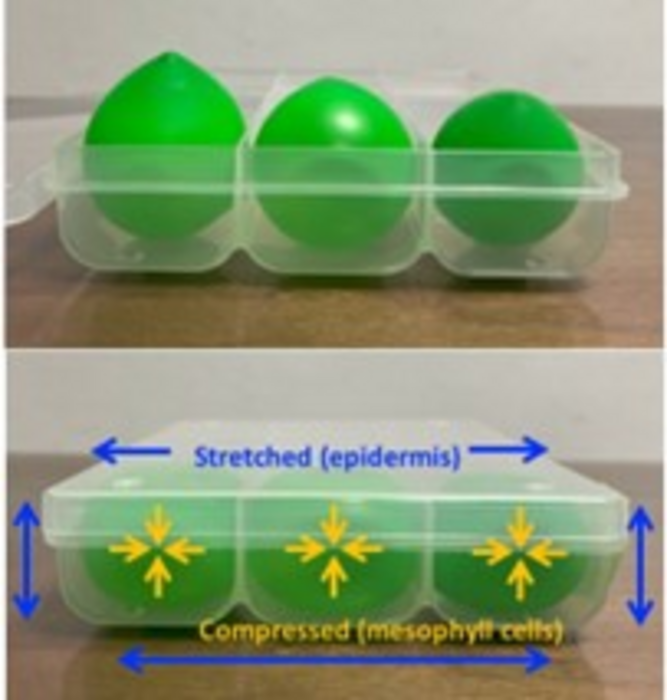Osaka, Japan – Plants have an impressive ability to regenerate damaged tissues, but how they do it is not fully understood. Now, researchers from Japan have discovered the mechanisms involved in this superpower.

Credit: Shinobu Takada
Osaka, Japan – Plants have an impressive ability to regenerate damaged tissues, but how they do it is not fully understood. Now, researchers from Japan have discovered the mechanisms involved in this superpower.
In a recently published study in Nature Communications, a research group led by Osaka University has revealed that cells within plant leaves may be able to detect mechanical pressure—or the lack of it—to determine where they are and what type of cells they become in response to damage.
In land plants, the epidermis is an outer layer of tissue that forms a boundary between the external environment and the plants’ internal tissues. It protects them from environmental stresses. Studying this cell type revealed that cell fate determination—how a cell develops into a final cell type—depends on a cell’s location within the developing plant; for example, the epidermis only contains surface cells.
“Until now, how the epidermis forms solely from the outermost cells of the plant was unknown,” says lead author of the study, Hiroyuki Iida. “In this study, we investigated the mechanisms of this process.”
To do this, the researchers peeled the epidermis off the leaves of seedlings using sharp forceps. This exposed cells of the mesophyll – the “middle leaf”, which underlies the epidermis and comprises layers of cells that specialize in photosynthesis – to the surface. This exposure triggered these cells to upregulate a gene called ATML1, which is known to promote epidermal cell differentiation.
“When we applied mechanical pressure to the exposed site, we found that this was enough to downregulate ATML1 expression in the outermost mesophyll cells,” says Shinobu Takada, senior author. “This result indicated that a release from this pressure was needed to activate ATML1 in the exposed mesophyll cells.”
These findings reveal that plant cells may be able to detect mechanical forces and determine their own position in relation to the leaf surface – whether they are located on the surface or in the inner tissues – and consequently differentiate into suitable cell types.
“Specifically, our results indicate that cues about where cells are in relation to the plant’s surface, for example through mechanical signaling, are used to confine ATML1 activity to cells on the surface, and enable the regeneration of epidermal cells,” explains Iida.
The results of this study have not only answered a long-standing question about the molecular targets for cell fate change in the epidermis and mesophyll of plant leaves, but also offer new insights into the mechanisms of position-dependent cell fate determination in plants, and a powerful tool for examining this aspect of plant physiology. This may in turn lead to an improved understanding of the mechanisms underpinning the high regeneration potential of plants.
###
The article, “Epidermal injury-induced derepression of key regulator ATML1 in newly exposed cells elicits epidermis regeneration,” was published in Nature Communications at DOI: https://doi.org/10.1038/s41467-023-36731-6
About Osaka University
Osaka University was founded in 1931 as one of the seven imperial universities of Japan and is now one of Japan’s leading comprehensive universities with a broad disciplinary spectrum. This strength is coupled with a singular drive for innovation that extends throughout the scientific process, from fundamental research to the creation of applied technology with positive economic impacts. Its commitment to innovation has been recognized in Japan and around the world, being named Japan’s most innovative university in 2015 (Reuters 2015 Top 100) and one of the most innovative institutions in the world in 2017 (Innovative Universities and the Nature Index Innovation 2017). Now, Osaka University is leveraging its role as a Designated National University Corporation selected by the Ministry of Education, Culture, Sports, Science and Technology to contribute to innovation for human welfare, sustainable development of society, and social transformation.
Website: https://resou.osaka-u.ac.jp/en
Journal
Nature Communications
DOI
10.1038/s41467-023-36731-6
Method of Research
Experimental study
Subject of Research
Not applicable
Article Title
Epidermal injury-induced derepression of key regulator ATML1 in newly exposed cells elicits epidermis regeneration
Article Publication Date
23-Feb-2023




